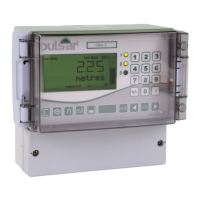Page 139
Control
P210, 220, 230 = 3 (Control)
When a relay is being set as a control relay, the second parameter that will
be displayed in the menu determines its function.
P211, P221, P231 - Relay Function,
This function allows the relay to be assigned to specific control functions
and mainly work in relation to time.
Relay will energise “ON” after the Cycle
time that is set in Relay Setpoint 2 (P214,
224, 234). And turns “OFF”, de-energises,
after the On-Time Period that is set in
Relay Setpoint 1 (P213, 223, 233)
Step Time Control allows relays to be used
to control a device, such as a motorised
valve or gate, to maintain the level within
two predetermined points. Relays will
energise “ON” when Step Time condition
is in effect and de-energises “OFF” when
Step Time goes off. One relay will be
required to control an increase in level,
(‘open’ the device) and a second relay is
required to control a decrease in level,
(‘close’ the device). Alarm ID (P212, 222,
232) is used to assign the relay to control
either the open or close condition. Step
Time Control relay requires three setpoints.
The first set point (P213, 223, 233)
determines the level, at which the relay is
to be activated, (N.B. level setpoint for
open relay, increase the level, must be
lower than the setpoint for the close relay,
decrease the level). The relay will
energise “ON” after the Limit time that is
set in Relay Setpoint 3 (P215, 225, 235).
And turns “OFF”, de-energises, after the
Drive Period that is set in Relay Setpoint
2 (P214, 224, 234).

